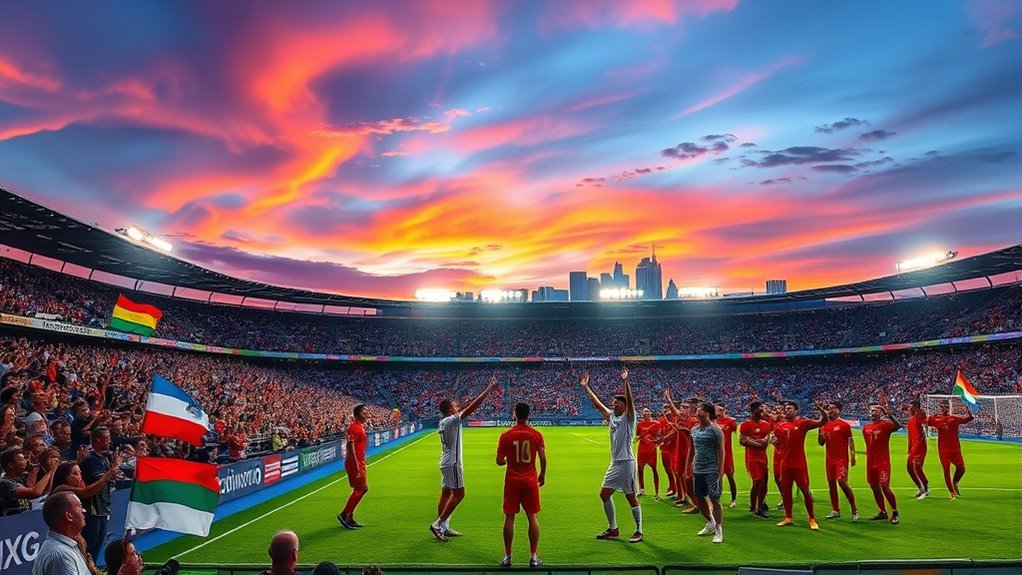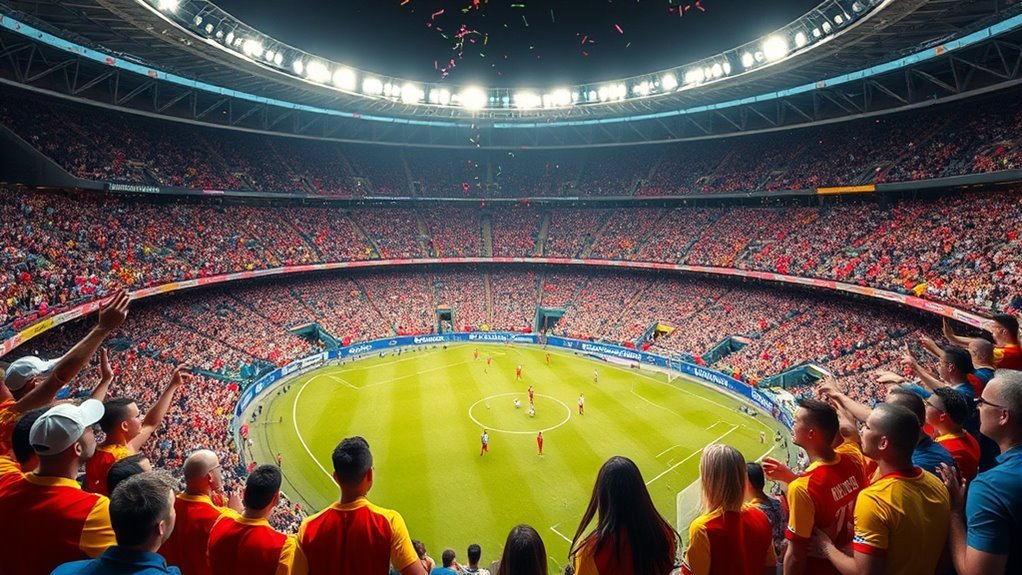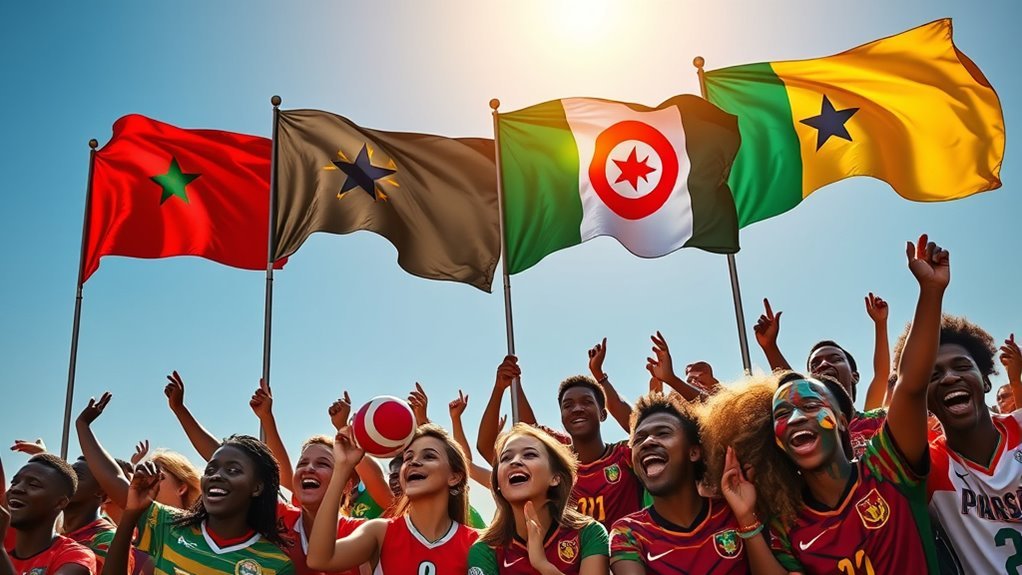The FIFA World Cup 2026 will feature an exciting 48 teams, combining established football powerhouses and rising nations keen to shine. You can expect traditional favorites like Brazil, France, and Germany to compete fiercely alongside emerging teams like Canada and Ghana. The expanded format promises thrilling matches and new competition dynamics. As the qualifiers unfold, you’ll discover even more about the teams making their mark in this pivotal tournament.
Overview of the FIFA World Cup 2026 Format
As the FIFA World Cup 2026 approaches, you’re likely curious about its format, which marks a significant change from previous tournaments. With the FIFA expansion, the competition will feature 48 teams instead of the usual 32, allowing more nations to participate and showcase their talent. This shift means that the tournament’s logistics will evolve, as organizing such a large event requires careful planning and coordination.
The format will consist of 16 groups of three teams each, with the top two teams from each group advancing to a knockout stage. This not only amplifies the excitement but also offers more opportunities for underdog teams to shine.
This expansion aims to celebrate global football, allowing fans to witness a broader range of cultures and playing styles. So get ready for a more inclusive and thrilling World Cup experience that promises to inspire freedom and unity through sport.
Current Qualifying Teams and Their Performance
With the expansion to 48 teams, the current qualifying phase for the FIFA World Cup 2026 is more competitive than ever. You’ll notice that nations are fiercely battling for their spots, showcasing their skills and determination. As you check the current standings, you’ll find that teams like Brazil and France are performing consistently well, while some underdogs are surprising everyone with their grit and talent.
The excitement is palpable as teams push their limits, knowing that every point counts. Fans are rallying behind their nations, celebrating each victory and mourning narrow losses. The performances are a reflection of the growth of football across the globe, as nations that once struggled are now making their mark.
Keep an eye on the qualifying matches; it’s a thrilling journey toward the ultimate goal of World Cup glory! The freedom to compete at this level brings out the best in every player.
Key Contenders: Traditional Powerhouses
While the qualifying rounds are still ongoing, it’s clear that traditional powerhouses like Brazil, Germany, and Italy are gearing up to reclaim their spots at the top of international football. You can’t overlook Brazil’s dominance, flaunting their skill and flair. Germany’s resilience is legendary, always bouncing back stronger. Italy brings a rich legacy, blending tactical genius with passion.
Don’t forget Argentina’s flair, which ignites the pitch with creativity. France showcases their prowess, a blend of speed and strength that’s hard to match. Spain’s artistry captivates fans, as they weave intricate passes. The Dutch ingenuity keeps their game fresh and innovative, while England’s tradition adds a historic rivalry. Portuguese skill dazzles, and Uruguayan tenacity keeps everyone on their toes. These nations are not just contenders; they embody the spirit of football, each aiming for glory in the upcoming World Cup.
Emerging Nations to Watch
Although the spotlight often shines on established teams, emerging nations are making impressive strides in international football, capturing the attention of fans and experts alike. Countries like Canada and Ghana have shown they’re ready to challenge the status quo. With a blend of emerging talent and fresh strategies, they’re not just aiming for participation; they’re eyeing significant upsets.
You might be surprised by how quickly some of these teams can rise to the occasion. Look at Morocco’s performance in the last World Cup, where they stunned many with their skill and determination. These surprise qualifiers bring a new energy to the tournament, reminding us that football’s beautiful unpredictability is alive and well.
As you gear up for the World Cup, keep an eye on these nations. They could become the underdog stories you’ll cherish for years to come.
Regional Qualifying Competitions
As we look ahead to the 2026 World Cup, understanding the regional qualifying competitions is vital. You’ll see a variety of formats and tournament highlights that shape which teams secure their spots. Keep an eye on some key teams that could surprise everyone as they aim for glory.
Qualification Format Overview
The qualification format for the FIFA World Cup 2026 introduces an exciting structure that reflects the growing global nature of soccer. This revamped qualification process is designed to give more nations a chance to compete on the world stage. Each confederation will have its own set of criteria, influencing how teams earn their spots based on team rankings and performance. You’ll see a mix of direct qualifications and playoff matches, which means every game matters. The emphasis on inclusivity allows underrepresented nations to chase their dreams. With more slots available, the competition will be fierce, but that’s what makes soccer so thrilling. Get ready to cheer for your favorite teams as they commence on this journey toward the ultimate prize!
Regional Tournament Highlights
With the new qualification format paving the way for more opportunities, regional tournaments are set to play a pivotal role in shaping the path to the FIFA World Cup 2026. You’ll witness some intense clashes fueled by regional rivalries, where teams fight for pride and glory. Expect the unexpected, as tournament surprises can turn the tables and leave fans in awe. Lesser-known teams might just stun the giants, proving that every match matters. These competitions not only showcase emerging talent but also bring communities together, uniting supporters in their shared passion. Keep an eye on these thrilling showdowns, where the spirit of freedom and competition reigns supreme, setting the stage for a World Cup filled with unforgettable moments.
Key Teams to Watch
While many teams are gearing up for their chance to qualify for the FIFA World Cup 2026, a few stand out as must-watch contenders in the regional qualifying competitions. Keep an eye on Brazil, with their dynamic key players like Neymar, who bring flair and creativity to the field. In Europe, France’s tactical strategies and depth in talent make them a formidable force. Don’t overlook the USA, as their young stars are enthusiastic to make an impact. In Africa, Senegal’s blend of experience and skill could surprise many. Each of these teams has a unique approach, and their journey through qualifying will showcase the beautiful game’s essence—freedom, passion, and the relentless pursuit of glory.
Impact of the Expanded Format on Team Participation
The expanded format for the 2026 World Cup means more teams will get a shot at participating, which is exciting for fans and players alike. You’ll notice changes in regional qualifications as different confederations adjust to this new opportunity. This shift could really reshape the tournament landscape and boost representation from various regions.
Increased Team Representation
FIFA World Cup 2026 will see a significant increase in team representation, expanding from 32 to 48 nations. This change means you’ll witness more team diversity on the world’s biggest stage, allowing countries that might’ve been overlooked to finally shine. Imagine the excitement as lesser-known teams step up, showcasing their talent and passion. With this expanded format, fans like you will experience a richer tapestry of global representation, celebrating cultures and styles from all corners of the globe. It’s not just about the heavyweights anymore; underdogs will have their chance to compete and inspire. This shift opens doors for nations to embrace their footballing dreams, promoting unity and freedom through the beautiful game. Get ready for a truly vibrant tournament!
Regional Qualification Changes
As the tournament expands to 48 teams, regional qualification processes will undergo significant changes, impacting how nations secure their spots in the World Cup. Countries will need to adapt to new qualifying criteria, which could reshape regional dynamics. Here’s what to expect:
- More slots for underrepresented regions: Expect more opportunities for nations in Africa and Asia to shine.
- Increased competition: With more teams vying for spots, the intensity of qualifying matches will rise.
- Revamped qualification formats: Regions may implement different structures, such as group stages or knockout rounds, to determine who advances.
These changes could empower nations that previously struggled, fostering a sense of freedom and excitement in the global football landscape. Get ready for a thrilling journey to the World Cup!
Historical Context: Previous World Cup Trends
Although many fans enthusiastically anticipate the upcoming FIFA World Cup 2026, understanding the historical trends of previous tournaments can provide valuable insight into what to expect. The World Cup’s rich history showcases patterns that reveal how certain teams rise and fall, driven by factors like player development and tactical evolution. For instance, looking at world cup statistics from past tournaments, you’ll notice that teams with strong youth programs often excel, maintaining competitive edges over time.
Additionally, the performances of host nations frequently shift, with home advantage leading to surprising successes. Trends also highlight how tactical innovations can redefine the game, influencing overall strategies. As you analyze these historical trends, consider how they might shape the narratives of future tournaments. By connecting the dots from the past, you’ll gain a more thorough understanding of what could unfold in the vibrant landscape of the upcoming World Cup.
Predictions for the Final Tournament Line-up
While it’s impossible to predict every detail of the final tournament line-up for the FIFA World Cup 2026, certain trends and team performances give us a clearer picture of potential contenders. As you look ahead, consider how these factors might shape your future predictions:
As the FIFA World Cup 2026 approaches, emerging teams and established powerhouses are set to shape potential contenders.
- Emerging Teams: Nations like Canada and the USA are rapidly improving and could surprise everyone.
- Established Powerhouses: Traditional favorites such as Brazil and Germany are always in the mix, bringing their rich histories and talent.
- Dark Horses: Countries like Croatia and Portugal have shown they can compete with the best, making them worth keeping an eye on.
As the tournament approaches, you’ll want to watch how teams perform in qualifiers and friendlies. These insights will help you form a solid idea of who might claim glory on the world stage in 2026. The excitement is just beginning!
Frequently Asked Questions
When and Where Will the FIFA World Cup 2026 Be Held?
The FIFA World Cup 2026 will take place in the United States, Canada, and Mexico. It’ll feature an expanded tournament format with host cities across these nations, allowing fans to celebrate soccer like never before.
How Many Teams Will Participate in the 2026 Tournament?
In 2026, 48 teams will participate, a significant team expansion from previous tournaments. This change means more nations can chase their dreams, but the qualification process will be tougher, fueling your passion for football’s global growth.
What Is the Age Limit for Players in the World Cup?
There aren’t strict age restrictions for players in the World Cup, so you can see a mix of young talent and seasoned veterans. Player eligibility is primarily based on national team selection rather than age limits.
Will VAR Technology Be Used in the 2026 World Cup?
Yes, VAR technology will be used in the 2026 World Cup. It’s aimed at enhancing officiating improvements, ensuring fair play, and giving you the freedom to enjoy the game without controversial decisions overshadowing the excitement.
How Can Fans Purchase Tickets for the 2026 FIFA World Cup?
You can purchase tickets for the 2026 FIFA World Cup through official FIFA channels. Keep an eye on their website for updates, ensuring you don’t miss out on the ultimate fan experiences and ticket purchasing opportunities.




